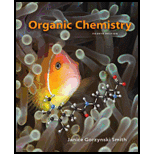
Concept explainers
(a)
Interpretation:
The second resonance structure for each given radical and its hybrid is to be drawn.
Concept introduction:
Most of the organic structures cannot be represented using single Lewis structure. Therefore, there exists more than one Lewis structure for representing a molecule or ion. These structures are known as resonance structures. These are the hypothetical structures and do not specify the exact structure. These resonance structure combine together to give resonance hybrid that is lower in energy and is the most stable structure.
The delocalization of electrons results in the formation resonance structure.
(b)
Interpretation:
The second resonance structure for each given radical and its hybrid is to be drawn.
Concept introduction:
Most of the organic structures cannot be represented using single Lewis structure. Therefore, there exists more than one Lewis structure for representing a molecule or ion. These structures are known as resonance structures. These are the hypothetical structures and do not specify the exact structure. These resonance structure combine together to give resonance hybrid that is lower in energy and is the most stable structure.
The delocalization of electrons results in the formation resonance structure.
(c)
Interpretation:
The second resonance structure for each given radical and its hybrid is to be drawn.
Concept introduction:
Most of the organic structures cannot be represented using single Lewis structure. Therefore, there exists more than one Lewis structure for representing a molecule or ion. These structures are known as resonance structures. These are the hypothetical structures and do not specify the exact structure. These resonance structure combine together to give resonance hybrid that is lower in energy and is the most stable structure.
The delocalization of electrons results in the formation resonance structure.
(d)
Interpretation:
The second resonance structure for each given radical and its hybrid is to be drawn.
Concept introduction:
Most of the organic structures cannot be represented using single Lewis structure. Therefore, there exists more than one Lewis structure for representing a molecule or ion. These structures are known as resonance structures. These are the hypothetical structures and do not specify the exact structure. These resonance structure combine together to give resonance hybrid that is lower in energy and is the most stable structure.
The delocalization of electrons results in the formation resonance structure.
Want to see the full answer?
Check out a sample textbook solution
Chapter 15 Solutions
Organic Chemistry
- Draw a second resonance structure for attached carbocation. Then draw the hybridarrow_forwardAdd the curved arrow(s) to each resonance structure that are necessary to convert it to the next structure. (The final resonance structure requires no curved arrows.)arrow_forwardA. Draw the major resonance structure, then draw curved arrows to show how this can be converted to the Lewis structure given. B. Thionitromethane is redrawn for you. Draw curved arrows to show how this can be converted to the resonance structure you drew in part A.arrow_forward
- Should the final resonance structure be included in the radical resonance? Or is the first and fifth structure the same?arrow_forwardDraw a second resonance structure for each carbocation. Then draw the hybrid.arrow_forwardCircle the molecule in each pair that is more stable, and write the reason why you selected that moleculearrow_forward
- Draw 4 resonance structures from the next cation.arrow_forward(a) Add curved arrows to show how the starting material A is converted to the product B. (b) Draw all reasonable resonance structures for B. (c) Draw the resonance hybrid for B.arrow_forwardDraw resonance for each structure pleasearrow_forward
 Organic Chemistry: A Guided InquiryChemistryISBN:9780618974122Author:Andrei StraumanisPublisher:Cengage Learning
Organic Chemistry: A Guided InquiryChemistryISBN:9780618974122Author:Andrei StraumanisPublisher:Cengage Learning
